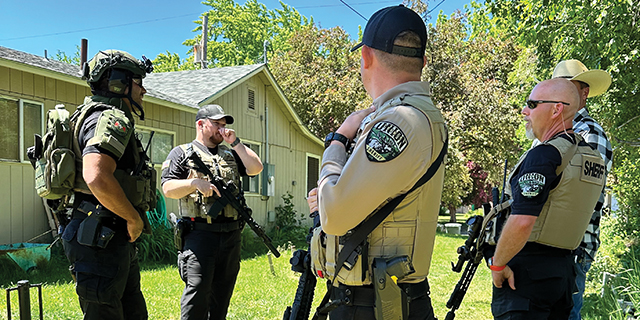Over the Blues: Spring magic on Mount Emily
Published 12:52 pm Friday, May 17, 2024

- Petersen
Thunderhead Theater is open for a matinee show.
The seating is the west side of the Grande Ronde Valley, a unique space about 16 miles wide and 25 miles long, surrounded by mountains. The audience is me, wife Wonder, a few other humans plus elk, deer, bear, cougar, badgers, rabbits and other wildlife that are cleverly hidden on the flanks of Mount Emily.
The show erupts on the east side of the valley. There, clouds in need of anger therapy rumble with thunder. Lightning flashes. Rain starts to pour. The storm curtain comes down, obscuring my old hometown of Cove, population 500.
My hiking partner and I pick up our pace. We want to get a short hike in before a predicted storm hits the west side of the valley. For the moment, we are basking in sunshine. The sky is royal blue.
We are on top of Fox Hill, a couple miles north of La Grande, hiking in the Mount Emily Recreation Area, which has about 45 miles of nonmotorized trails and 45 miles of motorized trails.
A friend who hikes MERA, a retired judge and talented photographer, has alerted us Indian paintbrush is in bloom. We drop everything and go. The flowers here, almost a mile above sea level and 2,000 feet above the valley floor, reach their peak April through June. Various species take turns as the star attraction, and now it is Indian paintbrush’s turn to take a bow.
The trail offers spectacular views over the valley. The road up Fox Hill from the Union County Fairgrounds maxes out at a 17% grade. We park and hike down through a campground to reach a motorcycle trail that runs up a draw and then out to an open ridge and a majestic viewpoint.
MERA is a 3,600-acre mixed-use area, one of the biggest “county parks” in Oregon. Trails attract mountain bikers, hikers, runners, motorcyclists, four-wheelers and horseback riding enthusiasts, and in winter snowshoers and cross-country skiers.
The trail we’re on, at least this day, is free of traffic. An obstacle course of puddles is quickly drying up in the draw. (Users are cautioned not to use trails when mud sticks to tires or shoes, as it doesn’t take much to undo a trail and hundreds of hours of volunteer work.)
I’m reminded that in the Grande Ronde Valley, oddly, May is on average wetter than April and June is wetter than May. Finally, about July 4 the spigot turns off and the area enters, as does the entire Northwest, relentless seasonal drought.
We pass a pole pile where two chipmunks play tag. The critters race with spectacular speed to see which can be “king of the mountain.” They then fly to hiding spots only to reemerge moments later to play the game again.
Deer and elk are common in the area, and black bears occasionally visit. (Another friend’s trail camera, posted in the forest near MERA, provides ample evidence.)
Many varieties of birds also enthusiastically enjoy the woods. On this warm afternoon, though, most critters are serenely napping.
We hike a short way before reaching a viewpoint. The hike is well suited for the entire family, as long as they can make way for motorcyclists roaring up the trail. None did on our visit.
Far below, La Grande goes about its Sunday business. Beyond is Ladd Marsh Wildlife Area, a sanctuary for both migratory and year-round waterfowl. Farther still is Hot Lake, now a resort. Long ago it was a summer rendezvous for several American Indian tribes, which gave this area its nickname, the Valley of Peace.
We find Indian paintbrush in profusion as well as fields of colorful lupine.
Here in MERA, the Indian paintbrush may be king of the mountain, but the chipmunks are a close second.
As always, leave only footprints and take only pictures. Whether in town or on the trail, leave your surroundings better than you found them.




